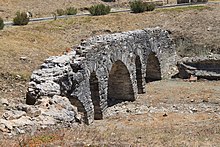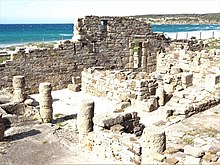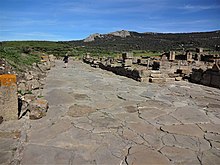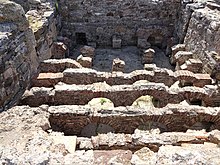Baelo Claudia
Baelo Claudia is a Roman ruined city and is located about 17 kilometers northwest of Tarifa in the direction of Cádiz on the Atlantic , right on Playa de Bolonia .
Baelo Claudia was founded around the 2nd century BC, but was only given the nickname Claudia in the 1st century AD under Emperor Claudius . The settlement emerged as a Roman manufacturing town for processing the fish caught, mainly tuna , and for the production of the coveted garum sauce . From here the products were exported to the entire Roman Empire, but above all to Rome. The settlement reached its peak in the two centuries after Christ. Baelo Claudia was abandoned by the Romans in the late 6th - early 7th century due to earthquakes and economic decline.
In 711 the Moors began their campaign of conquest of the Iberian Peninsula from this place and then ruled Andalusia for about 700 years .
You can visit today a. the remains of one of the three aqueducts used to supply the city with water, the well-preserved theater and the extensive basilica with a statue of the Emperor Trajan . The more recent excavation results include the eastern city gate, a bathing complex with hypocaust (underfloor heating) and the garum factory right on the beach.
Research and Public Relations
In 1990 the government of Andalusia set up the Archaeological Ensemble of Baelo Claudia ( Conjunto Arqueológico de Baelo Claudia ), which since then - in addition to public relations work - has been entrusted with the task of maintaining the excavation site permanently and continuing the research work. In December 2007 a comparatively large research center and museum - designed by the Andalusian architect Guillermo Vázquez Consuegra - was opened next to the ruins. Exhibitions provide information about the excavations and present artifacts that were found in the ruins, as far as they were not taken to the Museum of Cadiz or the Archaeological Museum of Madrid. International archaeological teams can investigate the excavation results in Baelo Claudia.
Since the excavation project is subsidized by the EU, among others, EU citizens have free entry to the museum and the excavation areas (on marked paths); Otherwise, admission costs 1.50 EU (as of August 2011). The museum, the exhibition and the parking lots will be closed at lunchtime.
tour
After you have passed the entrance to the museum, a 23-station tour of the outdoor area begins:
- 1: aqueduct
- 2 and 3: eastern city wall
- 4: east city gate
- 5: Fish factories for garum and residential areas
- 6: Market hall
- 7: southern forecourt
- 8: Forum
- 9: basilica
- 10: Tabularium (archive)
- 11: voting room
- 12: Curia
- 13: school
- 14: Tabernae (shops)
- 15: Administration building
- 16: Decumanus Maximus (main street)
- 17: western city gate
- 18: Therme
- 19: theater
- 20: Temple for Minerva, Iuppiter and Iuno
- 21: Isis temple
- 22: viewpoint
- 23: Exit gate
literature
- Roger Collins : Oxford Archaeological Guides Spain . Oxford 1998, pp. 68-71.
Web links
- Archaeological ensemble of Baelo Claudia . Junta de Andalucía, Consejería de Cultura y Deporte (in English and Spanish)
- Baelo Claudia (on die-roemer-online.de)
- Baelo Claudia - Visita Virtual , Ayuntamiento de Tarifa [with detailed panoramic images]
- Guillermo Vázquez Consuegra, Architect: Baelo Claudia Visitor Center (by Jesús Granada) [documentation of the museum's architecture, in Spanish]
Coordinates: 36 ° 5 ′ 23.6 " N , 5 ° 46 ′ 28.6" W.








